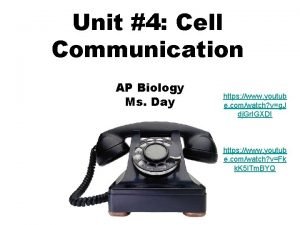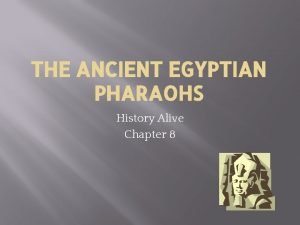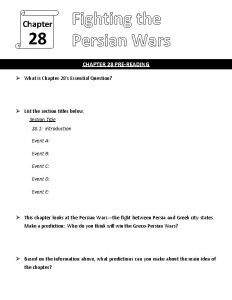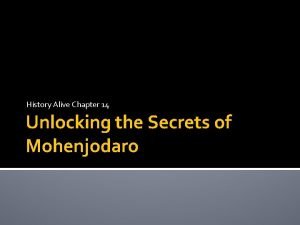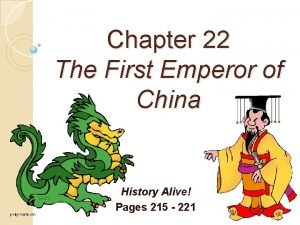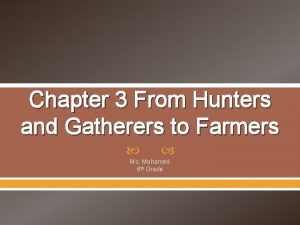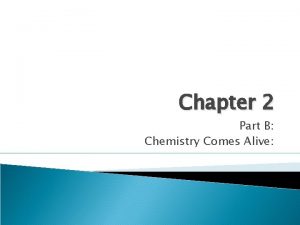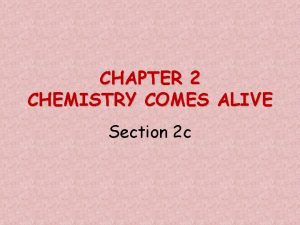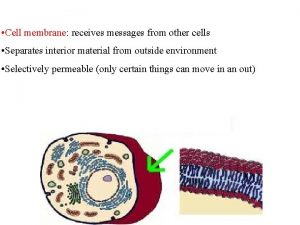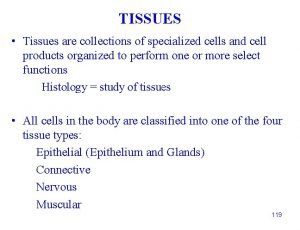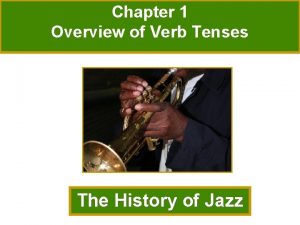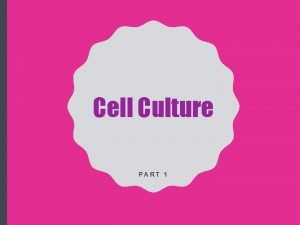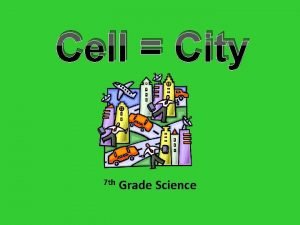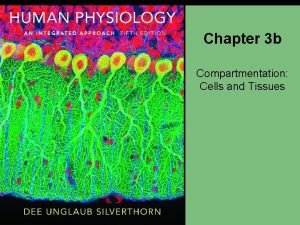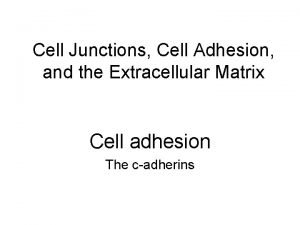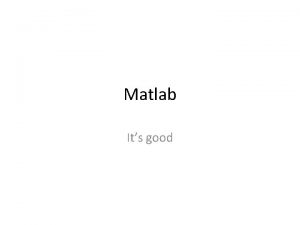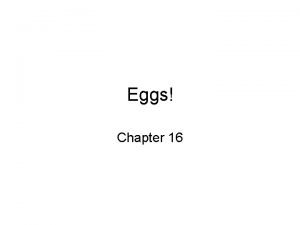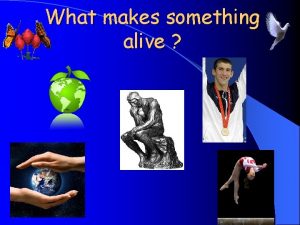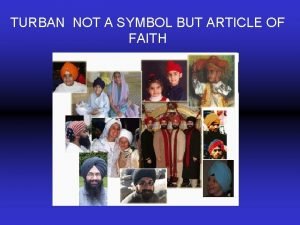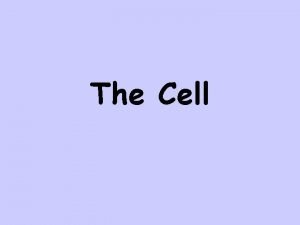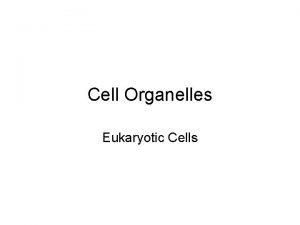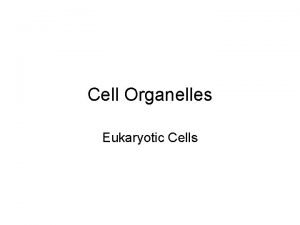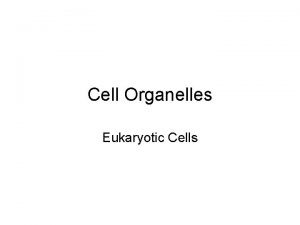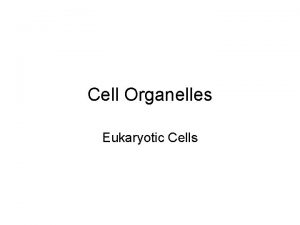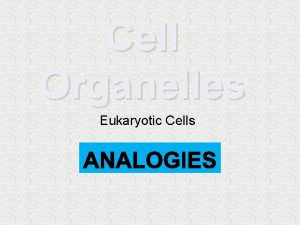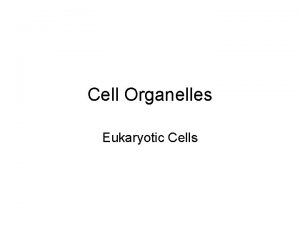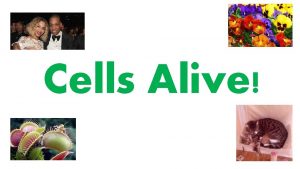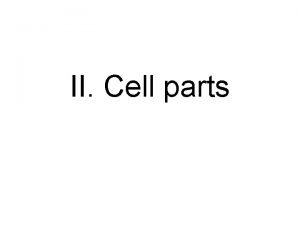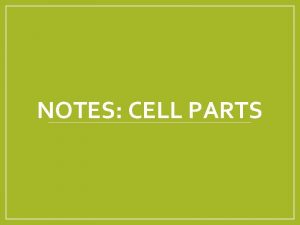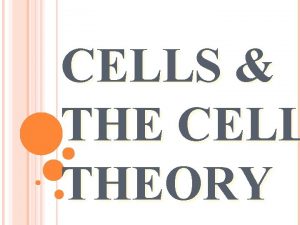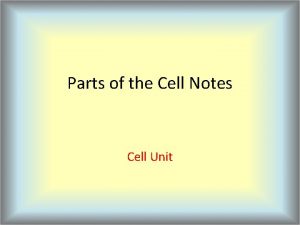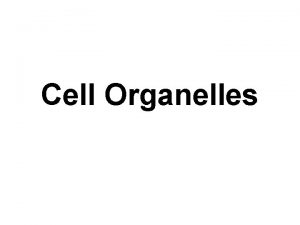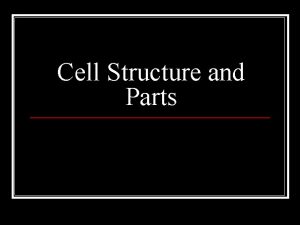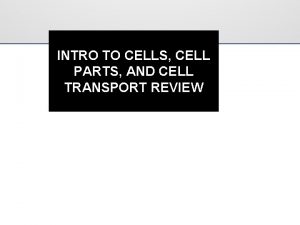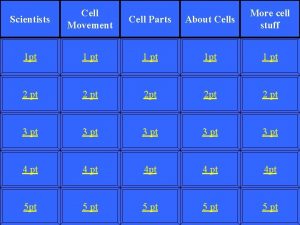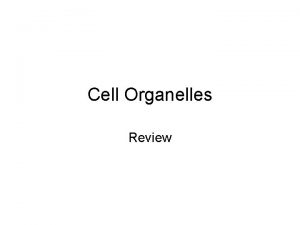Cells Alive Overview of Cell Parts Cells Chapter













































































- Slides: 77

Cells Alive Overview of Cell Parts Cells Chapter 3

Prefixes/Suffixes • • • Cyt- cell Endo- in Hyper- above Hypo- below Inter- between • • • Iso- equal Mit- thread Phag- eat Pino- drink -som - body

Now we are ready to review the cell

What is in the cell? • Most of the cell space is Cytoplasm. – Cytosol: Gel like fluid where most of the cells chemical reactions take place. • Organelles: Mini cell organs that carry out specific job functions for the cell.

What is the biggest organelle? • The nucleus – The control center for the cell – Contains DNA • Contains the message that makes proteins • Proteins run the cell. – Contains the organelle= nucleolus • Nucleolus makes RNA that carries out DNA’s instructions.


What surrounds the nucleus? • The Phospholipid membrane • Two membranes. • Keeps DNA in • Only RNA can leave

What are the major organelles? • Ribosomes: r. RNA. Where proteins are made. Usually on the rough ER. • Endoplasmic Reticulum: – rough ER close to the nucleus, where proteins are made – Smooth ER makes lipids. No r. RNA present. • Golgi Apparatus: Ships proteins and lipids.

More organelles… • Lysosomes: SOS. Contain digestive enzymes. Kill invaders and worn out cell parts. • Mitochondria: Power house of the cell. Makes ATP (Body runs on ATP energy. ) • Cytoskeleton: Skeleton of the cell. Shape • Centrioles: Move Chromosomes during cell division. • Microtubules: Basis for cilia and flagella

Mitochondria

Ribosome Endoplasmic Reticulum Golgi Apparatus

Cytoskeleton

Checkpoint • What is the functional difference between cilia and flagella? • What are the structural and functional differences between smooth and rough ER? • Which organelles contribute to synthesizing protein hormones and packaging them into secretory vesicles?

Interactive Cell Parts

Cell Membrane Fluid-Mosaic Model

What surrounds the cell? • The Plasma Membrane. Made out of Phospholipids. • May have cilia or microvilli around the cell. • Microvilli are in the back of your throat (filter air) and in your intestine (absorb food)

Why is the plasma membrane selectively permeable? • Works as a barrier. Only allows certain things in or out of the cell. • Means of protection. • Cells that can not do this are dead or damaged.


Checkpoint • List the three main parts of the cell and explain their functions. • Why are membranes said to have selective permeability?

Membrane Transport Pg. 47 -52

What are the two forms of cell transport? • Active Transport: uses energy (ATP) to move molecules against the concentration gradient or to move large things. • Passive Transport: uses NO energy to move molecules with the concentration gradient.

What types of Passive transport does the body use? • Diffusion: When molecules move from high to low or with the concentration gradient. – Perfume, food coloring, etc. all do this.

Simple Diffusion

Diffusion through a gated membrane channel

What types of Passive transport does the body use? • Facilitated Diffusion: Uses carrier proteins to move substances without energy with the concentration gradient. • Filtration: water and solutes are forced through a plasma membrane. Happens in the Kidneys.

Osmosis • Osmosis: a specialized form of diffusion which moves water from high to low across the plasma membrane.

Types of Solutions: Pg 50 • Isotonic Solution: Same tonicity inside and outside the cell. Cell stays the same size. • Hypertonic Solution: Higher tonicity outside the cell. Cell shrinks. • Hypotonic Solution: Lower tonicity outside the cell. Cell swells and “POPS”

Principles of osmosis applied to red blood cells

What types of Active Transport do you use? • Solute Pumping: Require protein carriers and energy to move sugars, Amino Acids, and ions against the concentration gradient. (Sodium Potassium pump used in Nerve cells)

Sodium-potassium pump

More Active Transport… • Bulk Transport: Substances too big to pass through the plasma membrane. – Exocytosis: Large things exit the cells – Endocytosis: Large things enter the cell • Phagocytosis: Cells that eat- white blood cell • Pinocytosis: Cells drink- intestine and kidneys

Phagocytosis

Checkpoint • How would having a fever affect body processes that involve diffusion? • If 0. 9% Na. Cl is isotonic saline solution for red blood cells, would a 2% solution of Na. Cl cause the red blood cells to expand or shrink? • What is the key difference between active and passive transport? • In what ways are endocytosis and exocytosis similar and different?

How Proteins are Made Pgs. 58 -62 Overview

What are the names of DNA? • Chromatin: Unwound DNA • Chromosomes: Tightly wound DNA

The Basic Process of Making Protein • DNA (In the Nucleus) is Transcribed into m. RNA. (Transcription) • RNA brings the message to the Rough ER where its Translated into a protein. (Translation)

Overview of transcription and translation

The Details: RNA (Ribonucleic Acid) • • • There are three types of RNA m. RNA (messenger RNA) r. RNA (Ribosomal RNA) t. RNA (Transfer RNA) RNA is Single Stranded, sugar is RIBOSE The Nitrogen bases for RNA are… – Adenine bonds to Uracil – Cytosine bonds to Guanine

The Story • DNA is stuck in the nucleus. • RNA is made in the nucleolus. • m. RNA transcribes or re-writes DNA’s code in RNA and leaves the nucleus through nuclear pores. • m. RNA brings the message to the ribosome also known as r. RNA.

The fairy tale continues • Once m. RNA is hooked onto the r. RNA it needs the right amino acids to make a protein. – Remember 50 or more A. Acids make a Protein! • t. RNA carries amino acids to the r. RNA and hooks them onto the correct m. RNA codon. – A codon is a three nucleotide sequence (AUG)

How does the story end? • When the stop codon is reached the Amino Acid chain falls off and rolls into a ball and becomes a protein. • m. RNA goes back to the nucleus to be reused. • r. RNA stays on the Endoplasmic Reticulum waiting for the next job. • t. RNA picks up new Amino Acids for the next job.

Transcription

Protein elongation and termination of protein synthesis during translation

Checkpoint • If the DNA template had the base sequence AGCT, what be the m. RNA base sequence? • What is the difference between transcription and translation?

Chromosomes and Mitosis Pg. 62 -65

Two different Cell Divisions • Meiosis- produces gametes or sex cells. New cells are different from the original cell. • Mitosis- produces new body cells-like your toes. New cells are identical to original cell.

DNA in all of its fine forms: • Chromosomes: Tightly wound DNA. Resemble an X because two chromatids are held together. Supercoiled. • Centromere holds the chromosomes (Two sister Chromatids) together. • Chromatid: A single tightly wound strand of DNA.

And last but not least… • DNA is your genetic information. In the shape of a double helix. The nucleotide pairs are: (Hydrogen bonds) – Adenine: Thymine – Cytosine: Guanine • DNA is broken into segments called genes which code for proteins. • Genes give your physical characteristics.

Before Eukaryotic Cells Divide… • Its chromosomes are replicated. • Happens through the process of DNA Replication: • DNA needs enzymes (protein) to copy or replicate itself. • Double helix unwinds using DNA Helicase. • DNA Helicase breaks the hydrogen bonds. • Where the DNA breaks apart is called the replication fork. DNA polymerase (another enzyme) adds nucleotides at this point.

How many Chromosomes do humans have? • Each somatic cell or body cell has two copies of 23 chromosomes. • One copy of the chromosomes (sex cells or gametes) have 23 chromosomes and are called haploid or n = 23. • Two copies of the chromosomes (somatic cells) have 2 n = 46.

There are two types of Chromosomes. • Autosomal Chromosomes: or autosomes are not sex chromosomes. • Sex Chromosomes: determine the sex of the individual. The male of the species determines the sex of the offspring. Women only have one X chromosome. Males have an X or a Y. • XX is a girl • XY is a boy

Karyotypes: Pictures of your DNA. • Why do we take pictures? To find mistakes

The 5 stages of the Cell Cycle • • G 1: Cell Growth and Metabolism S: DNA is copied G 2: Cell prepares for division. Mitosis: Nucleus divides, cell parts separate. • Cytokinesis: Cytoplasm divides


Mitosis: The Basic Steps • Prophase: DNA forms chromosomes. Nuclear envelope disappears. In Animals spindle fibers form. • Metaphase: Chromosomes move to the center of the cell- pulled by spindle fibers. • Anaphase: Chromosomes are separated into chromatids. Spindles shorten pulling chromatids to opposite ends of the cell. • Telophase: Nucleus reforms. Chromatids turn back into Chromatin. Spindles disappear.

Chromosomes





Cell Division and Mitosis

After Mitosis • Cytokinesis: Cytoplasm divides in half. • Animals: The plasma membrane pinches in half= Furrow. • Plants: A cell wall grows between the two new cells. Cell Plate.

When control of the Cell cycle is lost: Cancer is the outcome. • Cancer: uncontrolled cell division or death. • Read pg 66: Normal cells become cancerous.

Abnormal Cell Functioning - Cancer • Malignant – uncontrolled cell division – carried by lymph or blood to other organs to develop secondary tumors (metastasis) – Created by a mutation • Carcinogens, ultraviolet light • Benign – remain localized

Mitosis Interaction

Checkpoint • In which phase of the cell cycle does DNA replication occur? • Why must DNA replication occur before cytokinesis? • When does cytokinesis begin?

Meiosis: The making of gametes • One cell eventually creates four cells • Each cell is different from the parent cell • Haploid • Meiosis goes through cell division twice

The Stages of Meiosis • Prophase 1: Chromosomes are made and the nucleus membrane disappears. • Homologous Chromosomes pair and attach by centromeres. • Crossing-over occurs. Cross over is the process of homologous chromosomes breaking off and exchanging parts. – This process is responsible for making you unique!

Meiosis Animation

Why does Meiosis create genetic variation? • Crossing over. Mixes up the traits on each chromosome. • Independent assortment. You have 46 chromatids. ½ go to each new cell in Meiosis 1 and again in Meiosis II. No one knows which chromatids will go to which cell. • Random Fertilization. Which egg and which sperm will meet? = a greater genetic variability.

Making Gametes: Different for different sexes. • • • Egg formation: Ovum Sperm Formation • Oogenesis Spermatogenesis • One diploid germ cell One diploid germ makes one egg and cell makes four three polar bodies. haploid sperm • Egg must provide the cells. food for the zygote Occurs in the testis (fertilized egg) throughout the • Made in ovaries, most males adult life before birth

Sexual Reproduction: Two parents. • Offspring is genetically different from parents. • Great for environmental change. Easy to evolve. • Meiosis can better repair damaged DNA

Checkpoint • How does crossing-over affect the genetic content of the haploid gametes? • How are haploid and diploid cells different? • What are homologous chromosomes?

Sickle-Cell Anemia • Most common genetic disorder among people of African descent • Hemoglobin crystallizes when the oxygen levels are low and the red blood cells deform into sickles, which can clog and rupture capillaries causing internal bleeding • Incurable

Chapter Quiz

Cell Case Study

Stem Cells • Stem • Cell • Differentiation
 Alive alive alive forevermore
Alive alive alive forevermore He's alive frankenstein
He's alive frankenstein Http://www.cellsalive.com
Http://www.cellsalive.com Nondisjunction in meiosis
Nondisjunction in meiosis Cell signaling overview
Cell signaling overview The scientist mathias schleiden studied _______ in ______.
The scientist mathias schleiden studied _______ in ______. History alive the ancient world chapter 8
History alive the ancient world chapter 8 Persian wars definition
Persian wars definition History alive the ancient world chapter 14
History alive the ancient world chapter 14 History alive chapter 22
History alive chapter 22 From hunters and gatherers to farmers chapter 3
From hunters and gatherers to farmers chapter 3 Chapter 2 chemistry comes alive answer key
Chapter 2 chemistry comes alive answer key Drawing 9th amendment
Drawing 9th amendment Chapter 2 chemistry comes alive
Chapter 2 chemistry comes alive Sphenoid paranasal sinus
Sphenoid paranasal sinus Medullary portion of collecting duct
Medullary portion of collecting duct Parafollicular
Parafollicular Somatic cells vs gametes
Somatic cells vs gametes Why dna is more stable than rna
Why dna is more stable than rna Chlorocruorin
Chlorocruorin Eukaryotic cells vs prokaryotic
Eukaryotic cells vs prokaryotic Plant cell and animal cell venn diagram
Plant cell and animal cell venn diagram Prokaryotic cells
Prokaryotic cells Why did robert hooke name cells “cells”?
Why did robert hooke name cells “cells”? Masses of cells form and steal nutrients from healthy cells
Masses of cells form and steal nutrients from healthy cells Younger cells cuboidal older cells flattened
Younger cells cuboidal older cells flattened What cell type
What cell type Are red blood cells prokaryotic
Are red blood cells prokaryotic Cells cells they're made of organelles meme
Cells cells they're made of organelles meme Germ cell vs somatic cells
Germ cell vs somatic cells Collections of specialized cells and cell products
Collections of specialized cells and cell products Emt chapter 24 trauma overview
Emt chapter 24 trauma overview Emt chapter 14 medical overview
Emt chapter 14 medical overview Chapter 9 lesson 2 photosynthesis an overview
Chapter 9 lesson 2 photosynthesis an overview Chapter 12 selling overview
Chapter 12 selling overview Chapter 2 an overview of the financial system
Chapter 2 an overview of the financial system Chapter 1 overview of verb tenses
Chapter 1 overview of verb tenses Overview of personal finance chapter 1
Overview of personal finance chapter 1 Mesioclusion
Mesioclusion Personal finance chapter 1 review answers
Personal finance chapter 1 review answers General features of animals
General features of animals Chapter 1 an overview of financial management
Chapter 1 an overview of financial management Elements and their properties section 1 metals
Elements and their properties section 1 metals Chapter 1 overview of financial statement analysis
Chapter 1 overview of financial statement analysis Cell city project animal cell
Cell city project animal cell Difference between mercury cell and diaphragm cell
Difference between mercury cell and diaphragm cell Prokaryotic cell vs eukaryotic cell
Prokaryotic cell vs eukaryotic cell Prokaryotic cell and eukaryotic cell similarities
Prokaryotic cell and eukaryotic cell similarities Venn diagram of plant and animal cells
Venn diagram of plant and animal cells Concentration cell
Concentration cell Dry cell vs wet cell
Dry cell vs wet cell What is the function of a cell
What is the function of a cell Tonoplast
Tonoplast Structure of plant cell
Structure of plant cell Cell wall vs cell membrane
Cell wall vs cell membrane Morphology of cells in culture
Morphology of cells in culture Cell line vs cell strain
Cell line vs cell strain Cell city project
Cell city project Primary voltaic cell
Primary voltaic cell Difference between plant cell and bacterial cell
Difference between plant cell and bacterial cell Cell-cell junction
Cell-cell junction Cell-cell junction
Cell-cell junction What cell organelle is like lysol spray cleaning the cell
What cell organelle is like lysol spray cleaning the cell Events of the cell cycle
Events of the cell cycle Life
Life Carbohydrate side chain
Carbohydrate side chain Cell structure and function organizer
Cell structure and function organizer Idealized animal cell and plant cell
Idealized animal cell and plant cell Walker cell and hadley cell
Walker cell and hadley cell Cell cycle and cell division
Cell cycle and cell division Biology.arizona.edu/cell bio/activities/cell cycle/01.html
Biology.arizona.edu/cell bio/activities/cell cycle/01.html Cell cycle phases
Cell cycle phases Matlab string builder
Matlab string builder Galvanic cell and electrolytic cell
Galvanic cell and electrolytic cell Animal cell and plant cell
Animal cell and plant cell Drawing of
Drawing of What makes something alive
What makes something alive Bricked alive
Bricked alive




